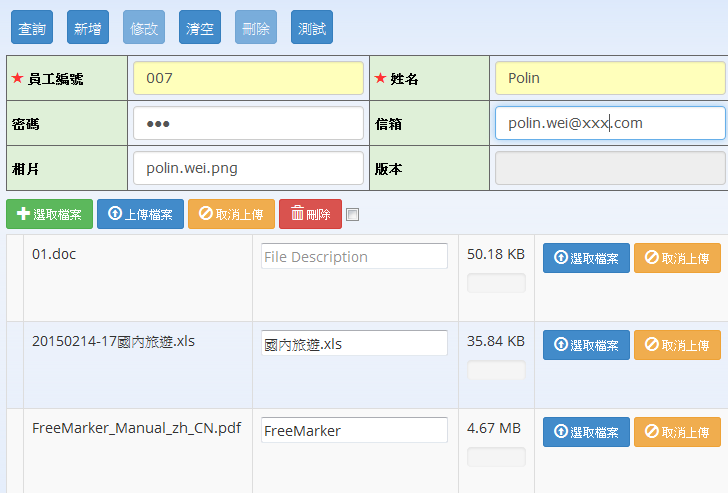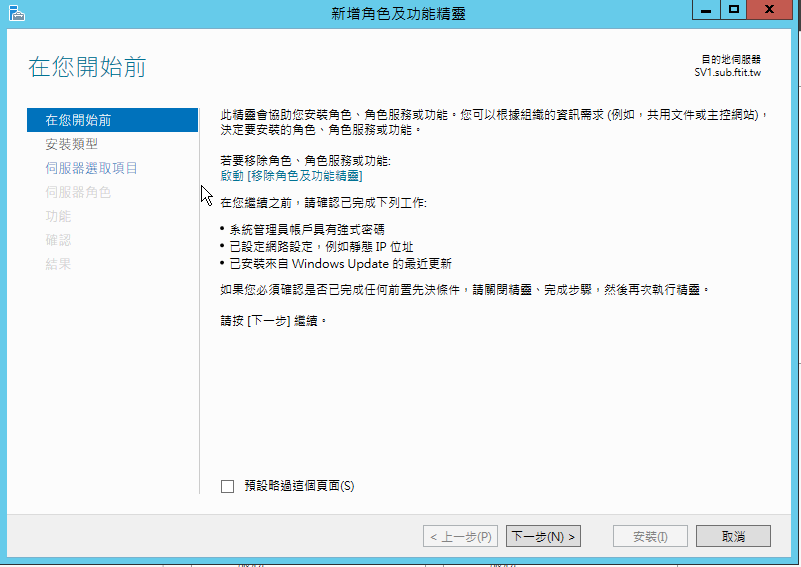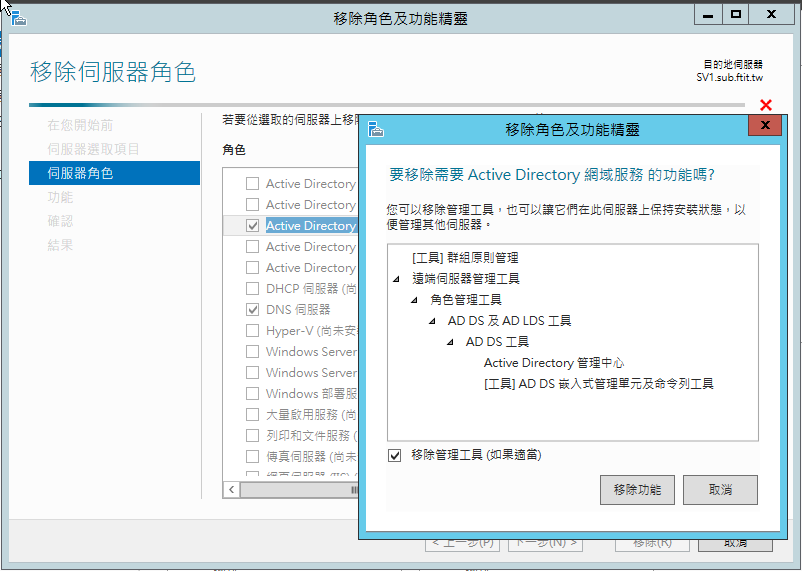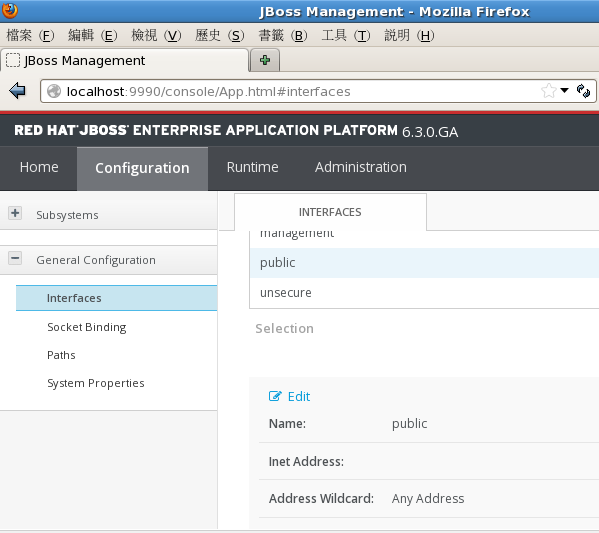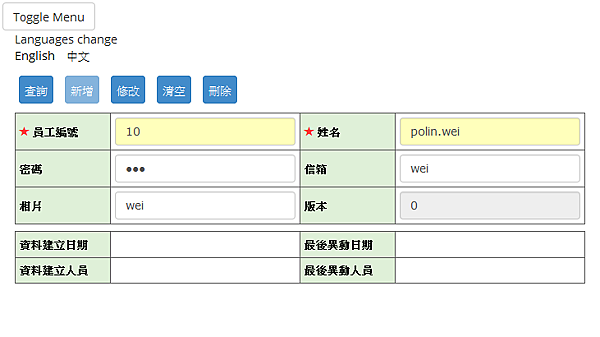From: Polin Wei
經實作測試,可以正常運作。故記錄之.....
環境:
struts2: 2.3.16.3
freemarker: 2.3.19
Bootstrap: 3.2.0
commons-fileupload: 1.3.1
commons-io:2.4
jQuery-File-Upload: 9.10.0
上傳前劃面
上傳後劃面
Struts2 結合 jQuery-File-Upload 的實作如下:
step 01: pom.xml
| <project xmlns="http://maven.apache.org/POM/4.0.0" xmlns:xsi="http://www.w3.org/2001/XMLSchema-instance" xsi:schemaLocation="http://maven.apache.org/POM/4.0.0 http://maven.apache.org/xsd/maven-4.0.0.xsd"> <modelVersion>4.0.0</modelVersion> <groupId>com.gu</groupId> <artifactId>GUSSH</artifactId> <version>0.0.1-SNAPSHOT</version> <packaging>war</packaging> <name>gussh</name> <dependencies> <dependency> <groupId>log4j</groupId> <artifactId>log4j</artifactId> <version>1.2.16</version> </dependency> <dependency> <groupId>javax.servlet</groupId> <artifactId>jsp-api</artifactId> <version>2.0</version> <scope>provided</scope> </dependency> <dependency> <groupId>com.google.code.gson</groupId> <artifactId>gson</artifactId> <version>2.3</version> </dependency> <dependency> <groupId>org.springframework</groupId> <artifactId>spring-core</artifactId> <version>4.1.1.RELEASE</version> </dependency> <dependency> <groupId>org.springframework</groupId> <artifactId>spring-context</artifactId> <version>4.1.1.RELEASE</version> </dependency> <dependency> <groupId>org.springframework</groupId> <artifactId>spring-web</artifactId> <version>4.1.1.RELEASE</version> </dependency> <dependency> <groupId>org.springframework</groupId> <artifactId>spring-orm</artifactId> <version>4.1.1.RELEASE</version> </dependency> <dependency> <groupId>org.springframework</groupId> <artifactId>spring-context-support</artifactId> <version>4.1.1.RELEASE</version> </dependency> <dependency> <groupId>org.springframework</groupId> <artifactId>spring-aspects</artifactId> <version>4.1.1.RELEASE</version> </dependency> <dependency> <groupId>org.springframework</groupId> <artifactId>spring-jdbc</artifactId> <version>4.1.1.RELEASE</version> </dependency> <dependency> <groupId>org.hibernate</groupId> <artifactId>hibernate-core</artifactId> <version>4.2.15.Final</version> </dependency> <dependency> <groupId>org.hibernate</groupId> <artifactId>hibernate-entitymanager</artifactId> <version>4.2.15.Final</version> </dependency> <dependency> <groupId>commons-codec</groupId> <artifactId>commons-codec</artifactId> <version>1.3</version> </dependency> <dependency> <groupId>org.apache.struts</groupId> <artifactId>struts2-core</artifactId> <version>2.3.16.3</version> </dependency> <dependency> <groupId>org.apache.struts</groupId> <artifactId>struts2-spring-plugin</artifactId> <version>2.3.16.3</version> </dependency> <dependency> <groupId>org.apache.struts</groupId> <artifactId>struts2-json-plugin</artifactId> <version>2.3.16.3</version> </dependency> <dependency> <groupId>org.apache.struts</groupId> <artifactId>struts2-config-browser-plugin</artifactId> <version>2.3.16.3</version> </dependency> <dependency> <groupId>commons-beanutils</groupId> <artifactId>commons-beanutils</artifactId> <version>1.8.0</version> </dependency> <dependency> <groupId>commons-lang</groupId> <artifactId>commons-lang</artifactId> <version>2.6</version> </dependency> <dependency> <groupId>commons-digester</groupId> <artifactId>commons-digester</artifactId> <version>1.7</version> </dependency> <dependency> <groupId>commons-httpclient</groupId> <artifactId>commons-httpclient</artifactId> <version>3.1</version> </dependency> <dependency> <groupId>com.thoughtworks.xstream</groupId> <artifactId>xstream</artifactId> <version>1.3.1</version> </dependency> <dependency> <groupId>p6spy</groupId> <artifactId>p6spy</artifactId> <version>1.3</version> </dependency> <dependency> <groupId>org.apache.poi</groupId> <artifactId>poi</artifactId> <version>3.0.1-FINAL</version> </dependency> <dependency> <groupId>quartz</groupId> <artifactId>quartz</artifactId> <version>1.5.2</version> </dependency> <dependency> <groupId>stax</groupId> <artifactId>stax</artifactId> <version>1.2.0</version> </dependency> <dependency> <groupId>com.sun.xml</groupId> <artifactId>saaj-impl</artifactId> <version>1.3</version> </dependency> <dependency> <groupId>javax.activation</groupId> <artifactId>activation</artifactId> <version>1.1</version> </dependency> <dependency> <groupId>com.sun.xml.stream</groupId> <artifactId>sjsxp</artifactId> <version>1.0.1</version> </dependency> <dependency> <groupId>taglibs</groupId> <artifactId>standard</artifactId> <version>1.1.2</version> </dependency> <dependency> <groupId>wsdl4j</groupId> <artifactId>wsdl4j</artifactId> <version>1.5.1</version> </dependency> <dependency> <groupId>oro</groupId> <artifactId>oro</artifactId> <version>2.0.8</version> </dependency> <dependency> <groupId>jasperreports</groupId> <artifactId>jasperreports</artifactId> <version>1.3.4</version> </dependency> <dependency> <groupId>jfree</groupId> <artifactId>jfreechart</artifactId> <version>1.0.9</version> </dependency> <dependency> <groupId>jfree</groupId> <artifactId>jfreechart-experimental</artifactId> <version>1.0.9</version> </dependency> <dependency> <groupId>com.itextpdf</groupId> <artifactId>itext-asian</artifactId> <version>5.2.0</version> </dependency> <dependency> <groupId>net.sf.json-lib</groupId> <artifactId>json-lib</artifactId> <version>2.4</version> <classifier>jdk15</classifier> </dependency> <dependency> <groupId>net.sf.barcode4j</groupId> <artifactId>barcode4j</artifactId> <version>2.0</version> </dependency> <dependency> <groupId>net.sf.morph</groupId> <artifactId>morph</artifactId> <version>1.1.1</version> </dependency> <dependency> <groupId>commons-beanutils</groupId> <artifactId>commons-beanutils-bean-collections</artifactId> <version>1.7.0</version> </dependency> <dependency> <groupId>dom4j</groupId> <artifactId>dom4j</artifactId> <version>1.6.1</version> </dependency> <dependency> <groupId>aspectj</groupId> <artifactId>aspectjrt</artifactId> <version>1.5.3</version> </dependency> <dependency> <groupId>axis</groupId> <artifactId>axis</artifactId> <version>1.4</version> </dependency> <dependency> <groupId>com.keypoint</groupId> <artifactId>png-encoder</artifactId> <version>1.5</version> </dependency> <dependency> <groupId>org.slf4j</groupId> <artifactId>slf4j-api</artifactId> <version>1.6.1</version> </dependency> <dependency> <groupId>commons-dbcp</groupId> <artifactId>commons-dbcp</artifactId> <version>1.2.2</version> </dependency> <dependency> <groupId>cglib</groupId> <artifactId>cglib-nodep</artifactId> <version>2.1_3</version> </dependency> <dependency> <groupId>javax.annotation</groupId> <artifactId>jsr250-api</artifactId> <version>1.0</version> </dependency> <dependency> <groupId>net.sf.ehcache</groupId> <artifactId>ehcache</artifactId> <version>1.3.0</version> </dependency> <dependency> <groupId>javax.transaction</groupId> <artifactId>jta</artifactId> <version>1.1</version> </dependency> <dependency> <groupId>com.sun.mail</groupId> <artifactId>javax.mail</artifactId> <version>1.5.2</version> </dependency> <dependency> <groupId>net.sourceforge.jexcelapi</groupId> <artifactId>jxl</artifactId> <version>2.6</version> </dependency> <dependency> <groupId>commons-javaflow</groupId> <artifactId>commons-javaflow</artifactId> <version>20060411</version> <scope>system</scope> <systemPath>${project.basedir}/src/main/webapp/WEB-INF/lib/commons-javaflow-20060411.jar</systemPath> </dependency> <dependency> <groupId>net.sourceforge.barbecue</groupId> <artifactId>barbecue</artifactId> <version>1.1</version> <scope>system</scope> <systemPath>${project.basedir}/src/main/webapp/WEB-INF/lib/barbecue-1.1.jar</systemPath> </dependency> <dependency> <groupId>lotus.sametime</groupId> <artifactId>STComm</artifactId> <version>1.0</version> <scope>system</scope> <systemPath>${project.basedir}/src/main/webapp/WEB-INF/lib/STComm.jar</systemPath> </dependency> <dependency> <groupId>lotus.sametime</groupId> <artifactId>NCSO</artifactId> <version>1.0</version> <scope>system</scope> <systemPath>${project.basedir}/src/main/webapp/WEB-INF/lib/NCSO.jar</systemPath> </dependency> <dependency> <groupId>lotus.sametime</groupId> <artifactId>CommRes</artifactId> <version>1.0</version> <scope>system</scope> <systemPath>${project.basedir}/src/main/webapp/WEB-INF/lib/CommRes.jar</systemPath> </dependency> <dependency> <groupId>com.wnjsoft.dlp</groupId> <artifactId>ds-orgimport</artifactId> <version>1.0</version> <scope>system</scope> <systemPath>${project.basedir}/src/main/webapp/WEB-INF/lib/ds-orgimport.jar</systemPath> </dependency> <dependency> <groupId>com.wnjsoft.dlp</groupId> <artifactId>ds-userimport</artifactId> <version>1.0</version> <scope>system</scope> <systemPath>${project.basedir}/src/main/webapp/WEB-INF/lib/ds-userimport.jar</systemPath> </dependency> <dependency> <groupId>com.ds.globeunion.wfclient</groupId> <artifactId>ds-wf-client</artifactId> <version>1.0</version> <scope>system</scope> <systemPath>${project.basedir}/src/main/webapp/WEB-INF/lib/ds-wf-client.jar</systemPath> </dependency> <dependency> <groupId>jasperreports</groupId> <artifactId>ireport</artifactId> <version>2.0.0</version> <scope>system</scope> <systemPath>${project.basedir}/src/main/webapp/WEB-INF/lib/iReport.jar</systemPath> </dependency> <dependency> <groupId>com.oracle</groupId> <artifactId>ojdbc14</artifactId> <version>10.2.0.3.0</version> <scope>system</scope> <systemPath>${project.basedir}/src/main/webapp/WEB-INF/lib/ojdbc14.jar</systemPath> </dependency> <dependency> <groupId>com.oracle</groupId> <artifactId>ojdbc14_g</artifactId> <version>10.2.0.3.0</version> <scope>system</scope> <systemPath>${project.basedir}/src/main/webapp/WEB-INF/lib/ojdbc14_g.jar</systemPath> </dependency> <dependency> <groupId>com.sun.xml</groupId> <artifactId>saaj-coms</artifactId> <version>1.0</version> <scope>system</scope> <systemPath>${project.basedir}/src/main/webapp/WEB-INF/lib/saaj-coms.jar</systemPath> </dependency> <dependency> <groupId>com.gu.apps</groupId> <artifactId>gu-taglibs</artifactId> <version>1.0.0</version> <scope>system</scope> <systemPath>${project.basedir}/src/main/webapp/WEB-INF/lib/gu-taglibs-1.0.0.jar</systemPath> </dependency> <dependency> <groupId>javax.sql</groupId> <artifactId>jdbc-stdext</artifactId> <version>2.0</version> <scope>system</scope> <systemPath>${project.basedir}/src/main/webapp/WEB-INF/lib/jdbc2_0-stdext.jar</systemPath> </dependency> <dependency> <groupId>com.jgeppert.struts2.bootstrap</groupId> <artifactId>struts2-bootstrap-plugin</artifactId> <version>2.0.0</version> </dependency> <dependency> <groupId>com.jgeppert.struts2.jquery</groupId> <artifactId>struts2-jquery-plugin</artifactId> <version>3.7.1</version> </dependency> <dependency> <groupId>com.ckeditor</groupId> <artifactId>ckeditor-java-core</artifactId> <version>3.5.3</version> </dependency> <dependency> <groupId>commons-fileupload</groupId> <artifactId>commons-fileupload</artifactId> <version>1.3.1</version> </dependency> <dependency> <groupId>commons-io</groupId> <artifactId>commons-io</artifactId> <version>2.4</version> </dependency> </dependencies> </project> |
step 02: struts.xml
| <?xml version="1.0" encoding="UTF-8" ?> <!DOCTYPE struts PUBLIC "-//Apache Software Foundation//DTD Struts Configuration 2.3//EN" "http://struts.apache.org/dtds/struts-2.3.dtd"> <struts> <!-- devMode is helpful when you want some extra logs for debugging --> <constant name="struts.devMode" value="false" /> <constant name="struts.i18n.encoding" value="UTF-8" /> <!-- Global message resource; Otherwise you will have seperate message resource for each Action --> <constant name="struts.custom.i18n.resources" value="com.gussh.sc.messages.messages" /> <constant name="struts.enable.DynamicMethodInvocation" value="true" /> <constant name="struts.multipart.maxSize" value="1048576000" /> <package name="gussh-default" namespace="/" extends="struts-default,json-default"> <interceptors> <interceptor name="authInterceptor" class="com.gussh.AuthInterceptor"></interceptor> <interceptor-stack name="gussh-stack"> <interceptor-ref name="fileUpload"> <param name="maximumSize">104857600</param> </interceptor-ref> <interceptor-ref name="authInterceptor" /> <interceptor-ref name="defaultStack"/> </interceptor-stack> </interceptors> <default-interceptor-ref name="gussh-stack"/> <default-action-ref name="UnderConstruction"/> <global-results> <result name="json-output">/gussh/common/json-output.jsp</result> <result name="error">/error.jsp</result> </global-results> <global-exception-mappings> <exception-mapping exception="java.lang.Exception" result="error"/> </global-exception-mappings> <action name="UnderConstruction"> <result>/templates/SSO/GUSSO.jsp</result> </action> <action name="FileOutput" class="com.gussh.common.utils.FileOutput" > <result name="success" type="stream"> <param name="contentType">application/octet-stream;charset=ISO8859-1</param> <param name="inputName">inputStream</param> <!-- 使用經過轉碼的檔名作為下載檔案名,downloadFileName屬性 對應action類中的方法 getDownloadFileName() --> <param name="contentDisposition">attachment;filename="${downloadFileName}"</param> <param name="bufferSize">4096</param> </result> </action> </package> <!-- Add addition packages and configuration here. --> </struts> |
Step03: jsp 頁面
|
<s:form cssClass="fileupload" name="UsersTagAction" action="UsersTagAction" enctype="multipart/form-data"> ... ... <div class="row fileupload-buttonbar">
...</s:form> |
step 04: freemarker(ftl) 頁面, 放在 html 最下面, 以便所有頁面共用
| <!-- The template to display files available for upload --> <script id="template-upload" type="text/x-tmpl"> {% for (var i=0, file; file=o.files[i]; i++) { %} <tr class="template-upload fade"> <td> <span class="preview"></span> </td> <td> <p class="name">{%=file.name%}</p> <strong class="error text-danger"></strong> </td> <td class="title"><input name="fileDescription" placeholder="File Description"></td> <td> <p class="size">Processing...</p> <div class="progress progress-striped active" role="progressbar" aria-valuemin="0" aria-valuemax="100" aria-valuenow="0"><div class="progress-bar progress-bar-success" style="width:0%;"></div></div> </td> <td> {% if (!i && !o.options.autoUpload) { %} <button class="btn btn-primary btn-sm start" disabled> <i class="glyphicon glyphicon-upload" style="font-size: 14px"></i> <span style="font-size: 12px">${action.getText('common.upload.select')}</span> </button> {% } %} {% if (!i) { %} <button class="btn btn-warning btn-sm cancel"> <i class="glyphicon glyphicon-ban-circle" style="font-size: 14px"></i> <span style="font-size: 12px">${action.getText('common.upload.cancel')}</span> </button> {% } %} </td> </tr> {% } %} </script> <!-- The template to display files available for download --> <script id="template-download" type="text/x-tmpl"> {% for (var i=0, file; file=o.files[i]; i++) { %} <tr class="template-download fade"> <td> <span class="preview"> {% if (file.thumbnailUrl) { %} <a href="{%=file.url%}" title="{%=file.name%}" download="{%=file.name%}" data-gallery><img src="{%=file.thumbnailUrl%}"></a> {% } %} </span> </td> <td> <p class="name"> {% if (file.url) { %} <a href="{%=file.url%}" title="{%=file.name%}" download="{%=file.name%}" {%=file.thumbnailUrl?'data-gallery':''%}><img src="${request.contextPath}/webTemplate/themes/gussh/images/Download-icon.png"/>{%=file.name%}</a> {% } else { %} <span>{%=file.name%}</span> {% } %} </p> {% if (file.error) { %} <div><span class="label label-danger">Error</span> {%=file.error%}</div> {% } %} </td> <td> <span class="size">{%=o.formatFileSize(file.size)%}</span> </td> <td> {% if (file.deleteUrl) { %} <button class="btn btn-danger btn-sm delete" data-type="{%=file.deleteType%}" data-url="{%=file.deleteUrl%}"{% if (file.deleteWithCredentials) { %} data-xhr-fields='{"withCredentials":true}'{% } %}> <i class="glyphicon glyphicon-trash" style="font-size: 12px"></i> <span>${action.getText('common.btn.delete')}</span> </button> <input type="checkbox" name="delete" value="1" class="toggle"> {% } else { %} <button class="btn btn-warning btn-sm cancel"> <i class="glyphicon glyphicon-ban-circle" style="font-size: 12px"></i> <span>${action.getText('common.upload.cancel')}</span> </button> {% } %} </td> </tr> {% } %} </script> </body> </html> |
Step 05: 處理 file upload 的 class
| package com.gussh; import java.lang.reflect.Method; import java.util.Locale; import java.util.Map; import java.util.regex.Pattern; import javax.annotation.Resource; import javax.servlet.http.HttpServletRequest; import javax.servlet.http.HttpServletResponse; import org.apache.log4j.Logger; import org.apache.struts2.ServletActionContext; import org.apache.struts2.dispatcher.mapper.ActionMapping; import com.gussh.common.utils.BA_TOOLS; import com.gussh.common.utils.BA_Validate; import com.gussh.sc.model.UserInfo; import com.gussh.spfs.SPFS_TOOLS; import com.opensymphony.xwork2.ActionContext; import com.opensymphony.xwork2.ActionSupport; import com.opensymphony.xwork2.Preparable; import com.opensymphony.xwork2.validator.annotations.DateRangeFieldValidator; import com.opensymphony.xwork2.validator.validators.EmailValidator; import java.io.File; import java.util.ArrayList; import java.util.List; public class BaseSupport extends ActionSupport implements Preparable { Logger logger = Logger.getLogger(BaseSupport.class); private static final long serialVersionUID = 1L; // 網頁會使用的 request, response, session public HttpServletRequest request = ServletActionContext.getRequest(); public HttpServletResponse response = ServletActionContext.getResponse(); public Map<String, Object> session = ActionContext.getContext().getSession(); //處理檔案上傳, 因 jQuery-File-Upload 一次處理一個檔案上傳, 所以不需使用 MultipleFileUploadUsingListAction protected File file ; protected String fileFileName ; protected String fileContentType ; protected String fileDescription ; @Resource(name="BA_TOOLS") protected BA_TOOLS baTools; public BaseSupport() { // TODO Auto-generated constructor stub } public void prepare() throws Exception { // TODO Auto-generated constructor stub } @Override public String execute() throws Exception { String reqCode="fileUpload"; String reqResult=""; reqResult=doReqCode(reqCode); return reqResult; } public String fileUpload() { String filePath="/upload/"; try { baTools.uploadFileToServer(response, filePath, file, fileFileName, fileContentType, fileDescription); } catch (IOException e) { // TODO Auto-generated catch block e.printStackTrace(); } return super.fileUpload(); } //執行其它自定的 reqCode Function public String doReqCode(String reqCode) { reqResult=INPUT; boolean result = false; Method[] methods = this.getClass().getMethods(); for (int i = 0; i < methods.length; i++) { Method method = methods[i]; if (reqCode.equals(method.getName())) { try { reqResult=method.invoke(this).toString(); result=true; } catch (Exception e) { this.addActionError(reqCode+": "+ getText("msg.system.methodExecuteError")); logger.info(e); } } } if (!result){ this.addActionError(reqCode+": "+ getText("msg.system.methodNotFound")); } return reqResult; } //處理檔案上傳 public File getFile() { return file; } public void setFile(File file) { this.file = file; } public String getFileFileName() { return fileFileName; } public void setFileFileName(String fileFileName) { this.fileFileName = fileFileName; } public String getFileContentType() { return fileContentType; } public void setFileContentType(String fileContentType) { this.fileContentType = fileContentType; } public String getFileDescription() { return fileDescription; } public void setFileDescription(String fileDescription) { this.fileDescription = fileDescription; } } |
Step 06: 公共程式的 class: BA_TOOLS
| @Service @Component("BA_TOOLS") public class BA_TOOLS extends BaseDataSource { static Logger loger = Logger.getLogger(BA_TOOLS.class.getName()); private static final ActionSupport actionSupport = new ActionSupport(); /** * 上傳檔案到主機上,並且變更原始檔名為 new Date().getTime() + extension * @param filePath 檔案路徑 * @param file 上傳的實體檔案來源 * @param fileFileName 上傳的實體檔案檔名 * @param fileContentType 上傳的實體檔案型態 * @param fileDescription 上傳的實體檔案說明 * @return * @throws IOException */ public String uploadFileToServer(HttpServletResponse response,String filePath, File file, String fileFileName, String fileContentType, String fileDescription) throws IOException{ String saveFileName = ""; String showFileDescript = fileDescription.isEmpty()?fileFileName:fileDescription; String uploadFileGson=""; InputStream is = null; OutputStream os = null; int BUFFER_SIZE = 8 * 1024; int fileSize=0; Gson gson = new GsonBuilder().enableComplexMapKeySerialization().create(); Map<String,Object> rowAttribute = new HashMap<String,Object>(); List<Map<String,Object>> fileAttribute = new ArrayList<Map<String,Object>>(); Map<String,Object> itemCategory = new HashMap<String,Object>(); String osName = System.getProperty("os.name"); if (!osName.equals("Linux")) { filePath = "C:" + filePath; } try{ //檢查是否有此Folder:filePath, 若無則建立 File filePathIsFolder = new File(filePath); if (!filePathIsFolder.isDirectory()) filePathIsFolder.mkdirs(); //取得上傳檔案的附檔名 String extension = ""; if (fileFileName.indexOf('.') > -1){ String[] tmp = fileFileName.split("\\."); extension = "." + tmp[tmp.length - 1]; } saveFileName = new Date().getTime() + extension; //開始將檔案讀出並寫入主機 is = new FileInputStream(file); fileSize=is.available(); File destFile = new File(filePath, saveFileName); os = new FileOutputStream(destFile); byte[] buffer = new byte[BUFFER_SIZE]; while(is.read(buffer)>0){ os.write(buffer); } is.close(); os.close(); //組成 jquery-file-upload 需要的 gson 格式 itemCategory.put("name", showFileDescript); itemCategory.put("size", fileSize); itemCategory.put("type", fileContentType); itemCategory.put("url", "FileOutput?name="+saveFileName); itemCategory.put("deleteUrl", "Index?reqCode=fileDelete&fileFileName="+saveFileName); itemCategory.put("deleteType", "POST"); fileAttribute.add(itemCategory); rowAttribute.put("files", fileAttribute); } catch (Exception e) { e.printStackTrace(); } finally{ if (null!=is){ is.close(); } if (null!=os){ os.close(); } } //產生 gson 字串 uploadFileGson=gson.toJson(rowAttribute); //回傳 gson 至前端 gsonOutput(response,uploadFileGson); return saveFileName; } /** * 在前端產生 Gson String * @param response * @param gsonString */ public void gsonOutput(HttpServletResponse response, String gsonString){ PrintWriter writer=null; response.setContentType("text/html;charset=UTF-8"); try { writer = response.getWriter(); } catch (IOException e) { // TODO Auto-generated catch block e.printStackTrace(); } writer.print(gsonString); writer.flush(); writer.close(); } } |
Step 07: 檔案下載的 class: FileOutput
| package com.gussh.common.utils; import java.io.ByteArrayInputStream; import java.io.File; import java.io.FileInputStream; import java.io.InputStream; import java.io.UnsupportedEncodingException; import javax.annotation.Resource; import javax.servlet.http.HttpServletRequest; import javax.servlet.http.HttpServletResponse; import org.apache.log4j.Logger; import org.apache.struts2.ServletActionContext; import com.opensymphony.xwork2.ActionSupport; public class FileOutput extends ActionSupport { static Logger logger = Logger.getLogger(FileOutput.class); @Resource(name="BA_TOOLS") protected BA_TOOLS baTools; public HttpServletRequest request = ServletActionContext.getRequest(); public HttpServletResponse response = ServletActionContext.getResponse(); private InputStream inputStream ; private String name; public InputStream getInputStream() { String filenamedownload = ""; String filePath="/upload/"; String osName = System.getProperty("os.name"); if (!osName.equals("Linux")) { filePath = "C:" + filePath; } filenamedownload = filePath+ "/" + this.getName(); try{ File file = new File(filenamedownload); if(file.length()>0) inputStream = new FileInputStream(filenamedownload); else inputStream = new ByteArrayInputStream("No Files".getBytes()); }catch(Exception e){ e.printStackTrace(); } //return ServletActionContext.getServletContext().getResourceAsStream(filenamedownload); return inputStream; } public String execute() throws Exception { return "success"; } public String getDownloadFileName() { String downFileName = name; try { downFileName = new String(downFileName.getBytes(), "ISO8859-1"); } catch (UnsupportedEncodingException e) { e.printStackTrace(); } return downFileName; } public String getName() { return name; } public void setName(String name) { this.name = name; } } |
Step 08: file upload 的 javascript
|
$(document).ready(function () { }); |
大致的作業如上.
參考網址:
Setting formData on upload start for each individual file upload
https://struts.apache.org/docs/file-upload.html
